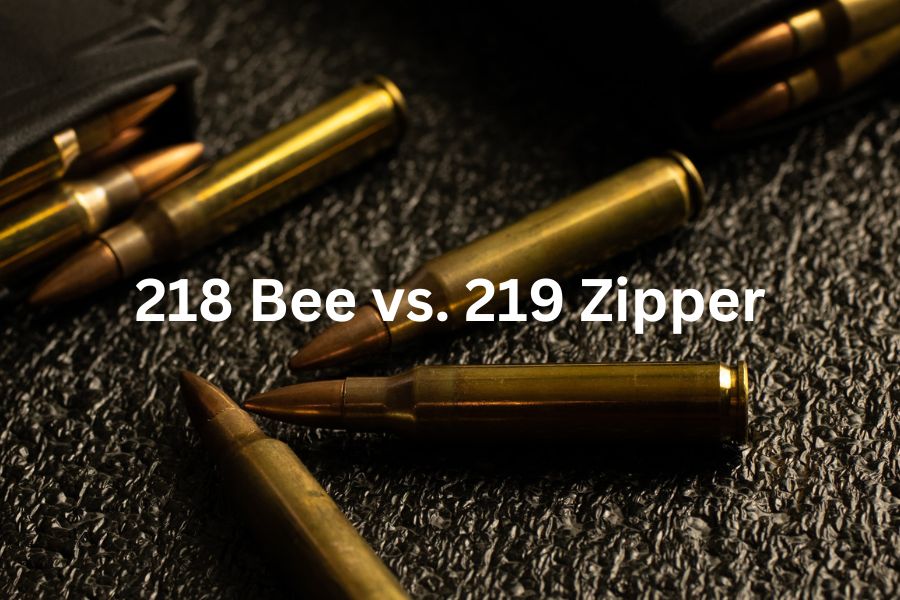When it comes to hunting rifles, there are many different calibers to choose from. Two popular options are the .218 Bee and the .219 Zipper. While both calibers have their fans, they each have unique strengths and weaknesses. In this article, we will take a closer look at these two cartridges, examining their ballistics, applications, and history, in order to help you decide which one is right for you.
Here is the short answer:
In brief, the .218 Bee is a smaller and faster cartridge, best suited for varmint hunting and small game. On the other hand, the .219 Zipper is a more powerful round, ideal for medium-sized game, such as deer and antelope, but is not as fast as the Bee.
Now that we have looked at the short answer, we an look in-depth at both cartridges, their ballistics, and we can compare both cartridges.
In-depth look at the .218 Bee
The .218 Bee was developed in the 1930s by Winchester, and was based on the .25-20 cartridge. It was designed as a varmint cartridge, and has a reputation for accuracy and flat trajectory. The Bee uses a .224-inch bullet, and has a muzzle velocity of around 2,700 feet per second (fps). It is often used for hunting small game, such as prairie dogs, groundhogs, and rabbits, as well as for pest control. The cartridge is relatively low-recoiling, which makes it a popular choice for younger or smaller-framed hunters.
Here is a ballistics chart of the 218 Bee with a 35-grain Spitzer bullet:
| range (YD) | drop (IN) | wind drift (IN) | velocity FPS | energy ft-lb |
| 0 | -1.5 | 0 | 3200 | 796 |
| 25 | -0.6 | 0.2 | 2970 | 686 |
| 50 | 0 | 0.6 | 2752 | 589 |
| 75 | 0.3 | 1.5 | 2544 | 503 |
| 100 | 0.3 | 2.8 | 2346 | 428 |
| 125 | -0.1 | 4.5 | 2157 | 361 |
| 150 | -0.9 | 6.8 | 1976 | 303 |
| 175 | -2.3 | 9.6 | 1804 | 253 |
| 200 | -4.5 | 13.2 | 1645 | 210 |
In-depth look at the .219 Zipper
The .219 Zipper, on the other hand, was developed in the 1930s by Winchester, and was based on the .30-30 cartridge. It was designed as a medium-game cartridge, and has a reputation for delivering a lot of energy to the target. The Zipper uses a .224-inch bullet, and has a muzzle velocity of around 2,500 fps. It is often used for hunting deer, antelope, and other medium-sized game. The cartridge is known for its stopping power, and can take down larger animals with a well-placed shot. However, it also produces more recoil than the .218 Bee, which may be a factor for some hunters.
Here is a ballistics chart of the 219 Zipper with a 50-grain Spitzer bullet:
| range (YD) | drop (IN) | wind drift (IN) | velocity FPS | energy ft-lb |
| 0 | -1.5 | 0 | 3400 | 1283 |
| 25 | -0.6 | 0.1 | 3290 | 1202 |
| 50 | 0 | 0.3 | 3184 | 1125 |
| 75 | 0.4 | 0.6 | 3080 | 1053 |
| 100 | 0.6 | 1.1 | 2978 | 985 |
| 125 | 0.6 | 1.7 | 2879 | 920 |
| 150 | 0.3 | 2.5 | 2782 | 859 |
| 175 | -0.3 | 3.4 | 2687 | 801 |
| 200 | -1.2 | 4.6 | 2594 | 747 |
In-depth comparison
When comparing the .218 Bee and the .219 Zipper, there are several factors to consider. Here are some key differences between the two cartridges:
Power: The .219 Zipper is a more powerful cartridge, and can take down larger game than the .218 Bee.
Speed: The .218 Bee is faster than the .219 Zipper, and has a flatter trajectory, making it better suited for varmint hunting.
Recoil: The .218 Bee produces less recoil than the .219 Zipper, which may be a factor for some hunters, especially younger or smaller-framed individuals.
Availability: While both cartridges are still in production, the .218 Bee may be harder to find than the .219 Zipper, which is still widely used for hunting.
Cost: The .218 Bee is generally less expensive than the .219 Zipper, due to its smaller size and lower demand.
Conclusion
In the end, the choice between the .218 Bee and the .219 Zipper will depend on your hunting needs and preferences. If you are primarily hunting small game, and value speed and accuracy, the .218 Bee may be the better choice for you. On the other hand, if you are looking for a cartridge that can take down larger game, and are willing to deal with more recoil, the .219 Zipper may be the way to go. Ultimately, both cartridges have their strengths and weaknesses, and either one can be an effective tool in the hands of a skilled hunter.

